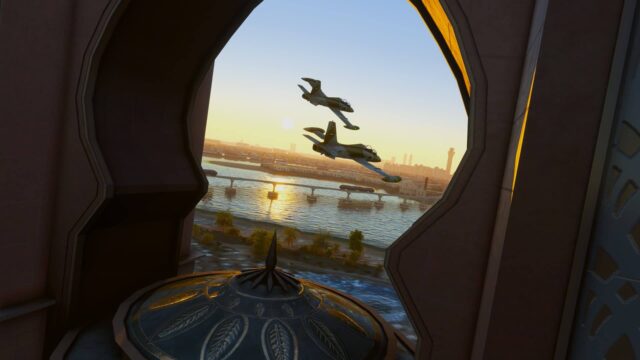 Late last year, Milviz released the T-38A Talon Advanced, a follow-up to their 2011 T-38A Jet Trainer. The main new features in the Advanced version are a custom flight dynamics and physics model, failure and damage modelling and a new, custom, flight control system. Intrigued, I got myself a T-38, and strapped myself in the front seat. Let’s see whether Milviz managed to convince this virtual pilot, shall we?
Late last year, Milviz released the T-38A Talon Advanced, a follow-up to their 2011 T-38A Jet Trainer. The main new features in the Advanced version are a custom flight dynamics and physics model, failure and damage modelling and a new, custom, flight control system. Intrigued, I got myself a T-38, and strapped myself in the front seat. Let’s see whether Milviz managed to convince this virtual pilot, shall we?
The real life Northrop T-38 was conceived when the United States Air Force issued a requirement for a supersonic trainer in the mid 1950’s. Northrop, working with own funds on a lightweight fighter called the N-156, decided to adapt this design for the trainer competition. Considered the underdog, they nevertheless managed to convince the Air Force to choose their design.
The first prototype YT-38 made its first flight in March 1959. The first production aircraft entered service with the USAF only 2 years later, in March 1961.
By the time production ended in 1972, 1187 aircraft had been built. Almost all as T-38A’s, the version Milviz simulates in this product.

The majority of T-38’s are used by the Air Education and Training Command of the USAF, although some other commands use them as proficiency, training or test aircraft as well. Still in the USA, both the Navy and NASA have a number of aircraft in service. Other countries that use the T-38 are Germany (although all fly in the US with USAF markings), Taiwan, Turkey, and formerly Portugal and South Korea.

The T-38 has seen several update and modification programs over its lifetime. Updated aircraft feature modern systems like a glass cockpit, and HUD, GPS and TCAS, among others. Other updates covered the engines, or aimed at extending the service life of the affected aircraft. Most aircraft were updated to the T-38C standard. The NASA update program resulted in the T-38N variant, and Turkey had their T-38A’s updated locally to the T-38M. Current USAF goals are to keep the T-38 in service past 2020 at least, a staggering 59 years after its entry into service.

Installation:
The Milviz T-38A Advanced is available through SimMarket for €56 (or US $60.88) excluding VAT. EU customers have to add their country’s VAT rate to this price.
After purchase, you get access to a single 185MB zip-file, which just contains a single installer in the form of an exe-file. I kind of like the way Milviz uses the build-date as part of the version number. It makes it easy to see how recent the version you have is.
Installation is simple but effective. You just run the installer, and it’ll guide you through the steps. No serial number is required. The installer let’s you pick which FS version you want to install into. A nice little feature is that it’ll only show you the simulators installed on your system as possibilities. You also use this installer to uninstall the aircraft, using a checkbox on the version selection screen.
In short, a pleasantly easy and trouble free installation.

The installation adds the Milviz T-38A Advanced to your simulator. It comes as one model, with 13 liveries. 7 of those 13 are USAF Thunderbirds liveries though, numbers 1 through 6 and a special “American Revolution Bicentennial” livery. The other liveries are various USAF paint schemes, and one NASA aircraft.

You also get a folder with a bunch of manuals. This folder can be found in the “T-38A_ADV_MilViz” folder in your simulations Airplanes folder.
You can also find 2 other remarkable additions here: some pre-made EZdok Camera Addon (EZCA) profiles, as well as some FSUIPC custom macro profiles. Very nice to see these shipped with the aircraft.
Visuals:
The T-38A Advanced uses the same model and textures as its predecessor, the T-38A Jet Trainer. Generally not a bad thing, because that was (and still is) a very good looking product.
The exterior modelling is nice and clean, with smooth curves and good attention to detail. It very nicely represents the iconic “coke bottle” shape of the aircraft. (See this Wikipedia article for the reason for this shape) The textures are also very good looking. Nicely detailed and well rendered textures that look clean, but not pristine. Very good quality.


Because they both use the same model, repaints made for the T-38A Jet Trainer should work on the ‘Advanced’. I’ve found that they mostly do, apart from an area at the back inside the air intakes that is left perfectly white when using legacy repaints in this new version.
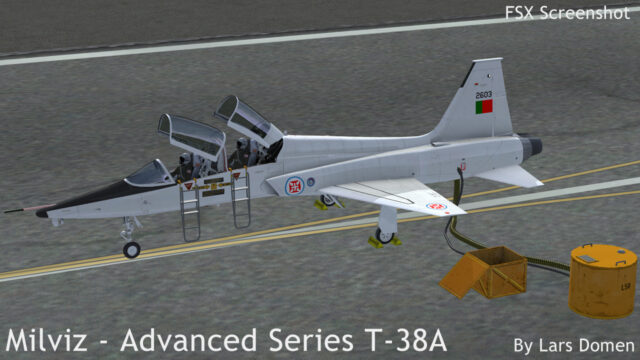
Inside the virtual cockpit, the story is much the same. Careful and detailed modelling topped off with good looking, sharp, textures. The results is a VC that really looks like a real one. It also shows this is an intensely used and well worn aircraft. A nice place to fly the aircraft from. Certainly a nice feature is that you can fly the T-38A from both seats. Indeed, both front and rear cockpits are modelled, with all relevant controls functional.


One aspect where the T-38A Advanced does show its age, is in the night lighting. I take it this was considered very good when the first Milviz T-38A was released, but I can’t say I think it looks good for a new high-end product. Inside, there are 3 lighting controls. One for instrument backlighting, one for console backlighting, and one for a white floodlight. All three are controllable in brightness, which really like. However, the implementation of the instrument light and the floodlight could be better. The floodlight reveals blocky patches of light instead of a nice gradient. It’s really not good enough for a product in this price class. The red instrument backlights are alright, but I’ve seen better. The overall red overlay could have been improved in my opinion.


Outside, I just can’t get my head around the landing light. Not how it works, Milviz very accurately modelled that aspect. But it just looks and behaves weirdly. First of all, the 3D light cone which should give it a volumetric feel, looks weird. Nice try, but I’ve seen much better. Especially in bright daylight, the light cone is much too visible. Looking at how the landing light actually lights the ground, things get weird. Sometimes, there’s a very good looking and realistic lighting effect. This looks good and feels immersive. More often however, I’m just seeing a generic, FS default, lit-up triangle. I’ve not seen these on a quality add-on product in a long time. The weirdest of all, is that I’ve actually seen it switch from the good looking version to the ugly version during taxi, without any discernible reason.


Flight Dynamics:
Without a doubt, the new flight dynamics engine and flight controls system are the selling points of this product. And not without cause. The flight dynamics are really good. Unfortunately, this also makes the aircraft notoriously difficult to handle for us armchair pilots. Generally speaking, and ignoring stuff like systems management, engine management, other traffic and the weather, handflying in real life is easier than in sim. The biggest reason for this is the ‘seat of the pants’ feeling that you lack in a sim, as well as being limited to a small 2D screen. Now consider the T-38A is a real pilots airplane, like a trainer should be, and you see where things get difficult.

The learning curve is steep, but this makes it even more rewarding when you get it right. Especially the extremely high roll-rate is something to get used to, but the same is supposedly true for the real aircraft.
The aircraft’s behaviour at high angles of attack seems very realistic as well, considering how small those wings are. There’s a very noticeable high-alpha buffet before stalling, which is very well simulated. Actually stalling the T-38A results in very high sink rates, but little to no noticeable attitude change, just as the documentation describes. Pull the aircraft into too high and angle of attack, and things can get dicey. It’ll gladly drop a wing in this situation, and those high roll rates make overcorrecting too easy. The T-38A is an aircraft you really want to stay ahead off.

But those are the special situation. Just basic flying the Talon requires some adjustment. Unlike a general aviation trainer, the T-38 will not turn just by banking a bit. You really have to pull it through a turn, which makes keeping an altitude not really easy.
Than being said, I’m not entirely convinced about how Milviz modelled the elevator response and trim. The latest patch made the aircraft actually flyable (it just about wasn’t before) but I’m still having a hell of a time getting it trimmed and stable.

One issue that I’ve noticed in both FSX and P3D is a very noticeable stutter when lifting off for the first time in a session. Perhaps a small issue, but one that can completely screw up what would otherwise have been a good takeoff.

Systems:
Let’s first say that this is an aircraft to be flown from the VC. There is no real 2D panel. That being said, there are a couple of popup panels available. First, there’s a 2D HUD superimposed over the screen. Not sure why, but it’s not in the way if you don’t use it. The second panel is a ‘Preflight Utility Panel’. This handy panel let’s you remove the pilots from the aircraft, or add a travel pod under the centre fuselage. You can also connect external power, in the form of either a ground cart, or fixed base power. Finally, you can select whether there are boarding ladders visible at or near the aircraft. Useful, easy to use, and to the point.

The final popup panel is a panel with 2 GPS units, a Garmin GNS 430 and a GNS 530, as well as a Bendix-King style GA autopilot panel. While I don’t think the GPS’s are necessary, I can understand them being included. The autopilot? Not so much. Certainly considering it doesn’t really work, but does screw up the aircraft when you turn it on. Why, Milviz? It’s just sloppy.
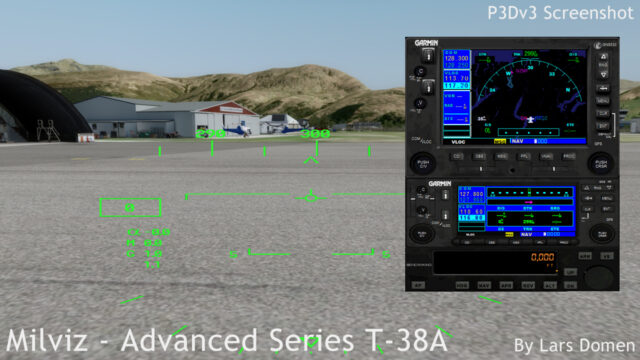
When moving on to the simulated systems, I can’t shake this feeling of sloppiness. Some items are done really well. The engines spring to mind here. Engine operations seem very realistic to me. Normal operations, but also compressor stalls, flame-outs, in-air restarts…
On other items, there are small oversights that are not too bad, but nevertheless should’ve been found and fixed in beta testing. The autopilot panel being the prime example. But there are also some guarded switches that can be toggled without lifting the guard, just to name something.

Of course there are items that aren’t simulated, or are just for show. Some items on the IFF panel that just have no place in FSX or P3D, or the canopy defog switch. I don’t mind this, not everything can be simulated.
But there’s also stuff that’s just broken. Take the flight director. It should work like any other flight director in ILS mode. Instead, the roll bar acts like a bank indicator, and I can’t figure out what the pitch bar is supposed to show. I’ve tested and tested, and read and reread the relevant part of the manual, but it just doesn’t work as it should. Considering how important this instrument is, I’d say that’s bad. Did they even put this aircraft through a decent testing period?

One thing that set’s the ‘Advanced’ version of the T-38A apart from the ‘normal’ version, is the inclusion of failures. Clearly, some work went into this feature. The Failure window is accessed through the ‘Add-ons’ drop-down menu in the FSX or P3D menu bar.
Failures can happen through mismanagement of the aircraft, by stuff just breaking due to the circumstances of flight. For example, overspeeding your landing gear, will result in blown tires, which in turn means no more braking… Overspeeding the flaps will break the flap mechanics, with asymmetrical flap extension in the worst case. All very, very nice to play around with. It really keeps your head with the aircraft.

Failures can also be triggered to happen within a certain time. Selecting a failure is limited to a specific system or subsystem, but how it fails remains random. Selecting an engine to fail, might cause one of your engines to just flame out, or it might just trigger some EGT fluctuations, or any number of other possibilities. It’s the pilots job to identify the problem and respond to it correctly.
I really like the addition of failures in this aircraft, but some more documentation or help would’ve been welcome. For example, it’s not clear in what format or what unit you should enter when a subsystem is to fail. Second, minutes, hours, litres, oranges?
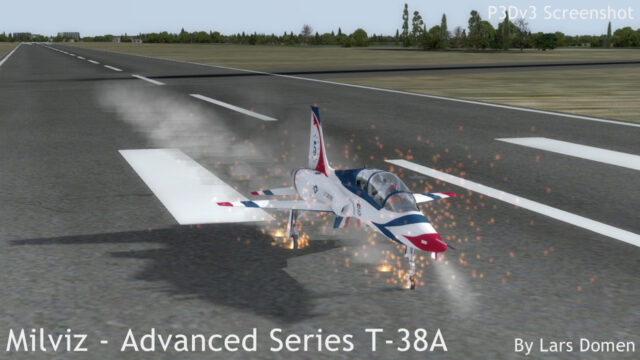
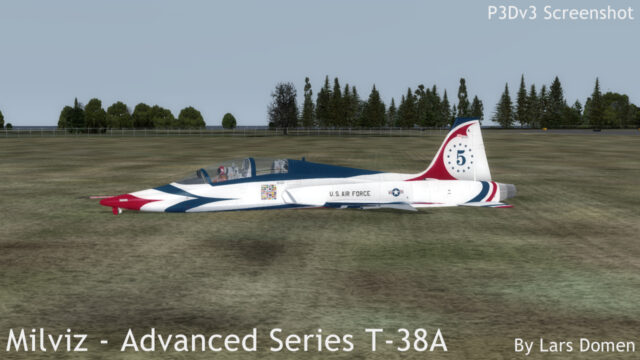
A recent addition in one of the January 2016 builds, is the option to set the aircraft to cold-and-dark through the failures window. A very welcome addition, and one that I use often. But again, the implementation seems rushed and sloppy. For example, it’ll force the aircraft to the so-called cold-and-dark state, even when just switching liveries in the air. Not very practical. It also seems extremely sensitive to your default flight state, or the state of the aircraft running before you select the Milviz T-38A. When switching from a running aircraft, to the cold T-38A, I’ve seen unstartable engines, or engines that start as soon as you switch the battery to ‘On’, and then invariable catch fire. I’ve also had lights that don’t respond to the position of the switch in the VC. All stuff that shouldn’t happen. If I carefully have to set my previous aircraft to cold-and-dark for that option to work on the T-38A, then why bother with that option at all?

Sounds:
The sounds in the Milviz T-38A Advanced are the same as those used in the Milviz T-38A Jet Trainer. It’s a very nice soundset that does a good job of making the aircraft immersive. Inside the VC, you get nice ‘clicks’ when actuating a switch. It gives clear feedback when you are clicking switches and knobs.
I’m also very pleased with the engine sounds in exterior views. The relatively small engines in the T-38 have a very characteristic high-pitched whine. This sound is there in the sim. The sound also changes noticeable when you change your camera position relative to the aircraft. In front, you hear more wheezing of air being sucked into the intakes. At the rear, you can expect more exhaust noise.
Generally, a very nice soundset.
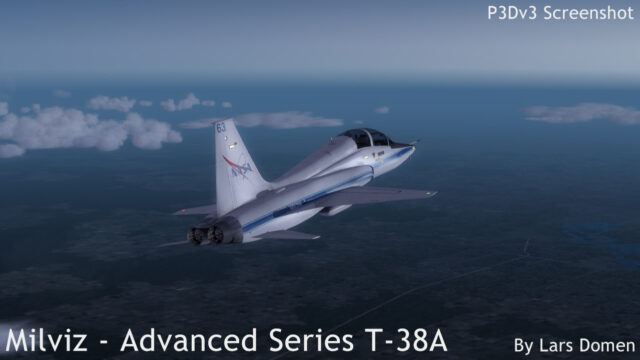
Documentation:
When you open the ‘Manuals’ folder that comes with the T-38A Advanced, you’ll find no less than 8 documents. 6 of those are PDF-files, 2 are MS Word files (docx-format). However, those Word files are exactly the same as 2 of the PDF-files. Again, this seems a bit sloppy. At the same time, those 2 documents are the only 2 that are specific for the T-38A Advanced. And even then, one of those documents, the 2 page ‘T38 ADV failures description’ is copied exactly in the 12 page ‘T-38A_ADV_manual_v3’ file.
That being said, the documentation specific for the ‘Advanced’, is limited to basically a repeat of the product page, some FAQ’s, and then a very limited and completely insufficient part about the failures.
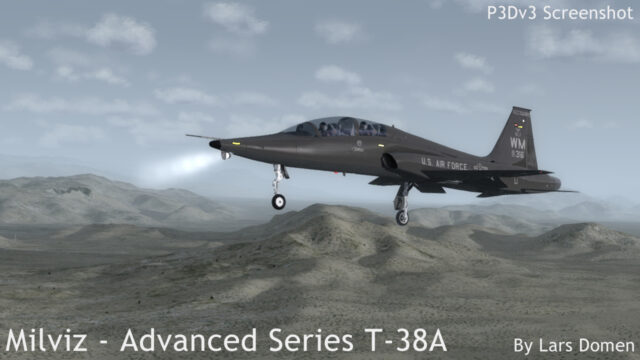
What about the other 4 manuals? Well, 2 are for the GPS units, were written for the Milviz Cessna 310 and still have the formatting and heading for that product. The other 2 manuals are longer and more useful ones, namely a ‘Quick Guide’ and a ‘Pilot’s Operating Handbook’ which were written for the T-38A Jet Trainer, and thus don’t cover any of the peculiarities of the ‘Advanced’ product. Even when ignoring this, I can’t say I like the POH document. I like that fact that it’s written in a style that mimics a real POH. On the other hand, it constantly mixes real world and simulation information, with no clear distinction between the two.
For such a detailed, high-end product that the Milviz T-38A Advanced is made out to be, the documentation is a clear fail.
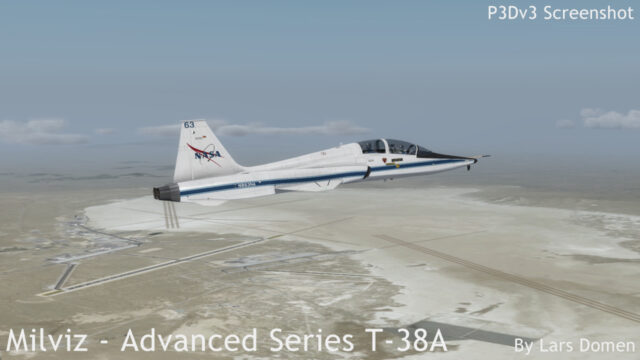
Conclusion:
My first impressions of the Milviz T-38A Advanced were quite good. And indeed, it really has strong points. It’s a product with a potential for excellence. It builds upon a very well received product from 2011. And the areas in which it differs from its predecessor show very good ideas on how to take the product to a higher level.
However, there are too many aspects of this product that feel sloppy or rushed. Simple things that should have been found and fixed during beta testing, or the fact that Milviz couldn’t be bothered to write a decent manual specific for the ‘Advanced’. If you then consider the price of the full product, around US $60 (or, when adding VAT, almost €70 for EU customers), which definitely isn’t cheap, you end up with something which is unrespectful to paying customers. It could have been a great product. But at this time, it still requires a great deal of improvement and polishing before I would consider it worth the price they ask for it.
Milviz proudly states on their website that their motto is: “Quality, or why bother?”. While the Advanced Series T-38A Talon shows a lot of promise and potential, it doesn’t sit squarely in the ‘Quality’ category just yet. Going by Milviz’s own motto, that would make the final verdict: “Why bother?”

Like:
- Very nice model and textures
- Good sound set
- Very realistic and believable flight dynamics
- Failures!
- Both front and rear cockpits functional
Don’t like:
- Too many small issues, and some big ones, regarding the systems and options.
- Terrible documentation. No decent manual in a US$60 product?
- Unimpressive night lighting
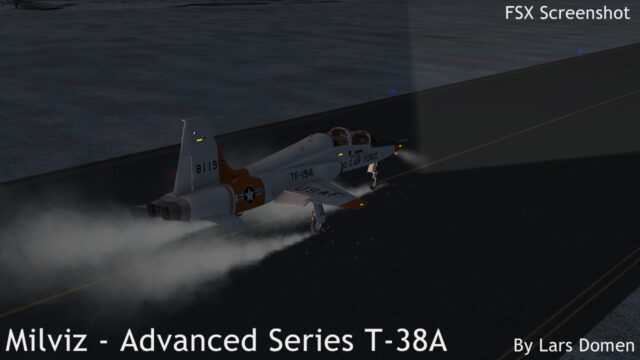
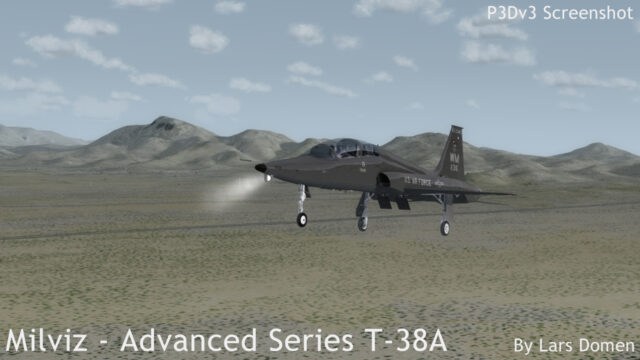
Useful links:
Software used:
Active Sky Next
FSFX Packages PrecipitFX
MyTraffic X
Orbx FTX Global
Orbx NZQN Queenstown
Real Environment Extreme Texture Direct + Soft Clouds
Sheppard Air Force Base by Jim Dhaenens (freeware)
Ultimate Terrain X Europe v2
Test System:
Intel Core i5-2500K @ 4×4.4GHz
8GB DDR3 RAM
MSI GTX 960 Gaming 2G
Windows 7 64 bit
FSX Deluxe + Acceleration
Prepar3D v3.1










